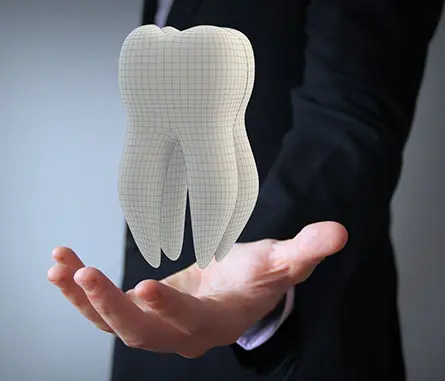Tooth Replacement
You may not fully appreciate your teeth until one or more are missing. Teeth are designed to work together to help you chew, speak, and smile. The loss of a back tooth may even cause your mouth to shift and your face to look older. Fortunately, missing teeth can be replaced with implants, crowns, bridges, and partial dentures.
See pictures of Woodland Dental clients who have had teeth repaired or replaced.
Implants

Implants are posts that are surgically placed in the upper or lower jaw, where they function as a sturdy anchor for replacement teeth. Implants can replace a single tooth or several teeth, or they can support a full set of dentures. If you think implants might be right for you, take a look at some of our clients who have had gotten them.
Generally there are three phases of implant treatment. Treatment takes from 4 to 6 months, depending on how quickly you heal.
- Placement of the implant—The dentist surgically places the implant into the jawbone.
- The healing process—Bone grows around the implant and holds it in place, making the implant strong.
- Replacing your missing tooth—A custom-made crown is made to fit your mouth and implant.
Advantages of implants:
- most similar to a natural tooth
- nearby teeth do not have to be involved in the placement procedure
- may last for many years, even decades
- some types of implants can be placed in just one or two visits
- may help prevent shrinkage of the jawbone from tooth loss
Disadvantages of implants:
- are not right for everyone since they require surgery
- may take longer and may require more dental visits than other options
- may cost more than other treatments
Bridges

A bridge is used when one or more teeth have been lost. To repair and replace the gap with a tooth (pontic), we first take an impression so that crowns can be made for the two teeth on either side of the missing tooth. These two crowns will support the pontic. A temporary bridge is made and placed until the permanent bridge is ready and cemented into place.
Advantages of bridges:
- look, feel and function like natural teeth
- don’t require removal for cleaning
- cost less than implants
Disadvantages of bridges:
- likely to be more expensive than a removable partial denture
- affect the teeth next to the missing tooth
- may require extra effort to clean under the pontic
Partial Dentures

A removable partial denture is easily be taken out of the mouth for cleaning. Partial dentures usually have replacement teeth fixed to a plastic base that matches the color of your gums. The plastic base may cover a metal framework. Partial dentures often have some form of a clasp that attaches to your natural teeth.
Advantages of removable partial dentures:
- usually less expensive than fixed bridges or implants
- usually easier to repair than fixed bridges
Disadvantages of removable partial dentures:
- can be less stable than other choices
- may break or be lost
- can be uncomfortable
- some people are embarrassed to take out their teeth at night and for cleaning
- may need more frequent replacement than other options
